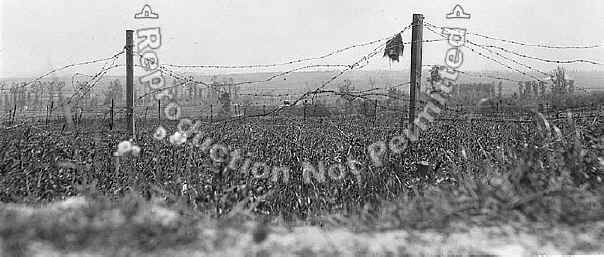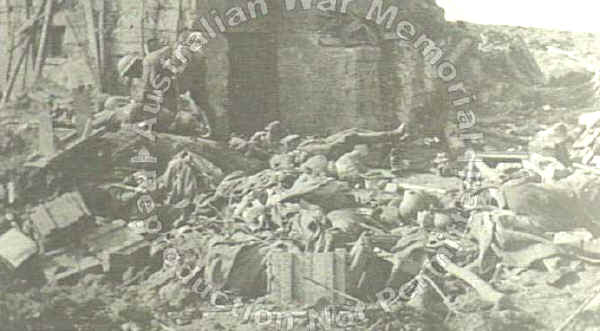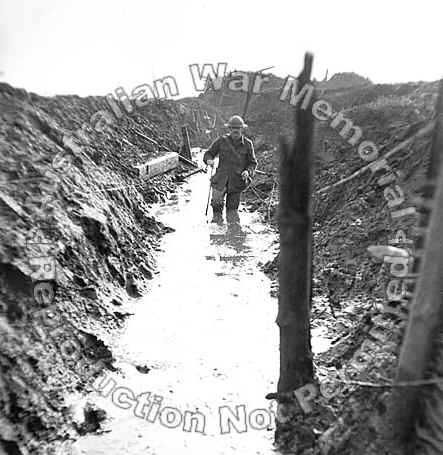 |
| Category: Western
Front |

|
|
|
|
|
|
Messines, often called
Messines Ridge |
|

|
| A
German concrete shelter on the hill at Messines, in Belgium. The
entrances are just showing above ground, and the pockets over them hold
machine gun and revolver ammunition; above can be seen the remains of
the camouflage, which concealed the dugout from aircraft observers. From
this position the enemy commanded a long stretch of an important road. |
- German losses at Messines numbered 25,000,
of which 7,500 were prisoners. British Empire casualties were 17,000
killed or wounded.
|
 |
| The
Messines Ridge, in Flanders, was attacked on 7 June 1917, the II Anzac
Corps, forming the right of the British attack. (The New Zealand
Division took Messines, the 4th Australian Division continuing the
assault beyond it, and the 3rd Australian Division attacking on the
right of the Army). The ruins of the village itself can be discerned on
the crest of the distant hill. The attack, in this sector of the battle,
was made from the foot of the nearer hill.
|
At 0310 hrs on Thursday
7th June, 1917 the British Second Army under General Sir Herbert Plumer
started an attack which in three hours resulted in the capture of the
whole of the Messines Ridge on the south side of the Ypres Salient.
 |
The attack effectively began on 3rd
June when the preliminary bombardment intensified, and was kept up until
0250 hrs on 7th June.
By this time, 100,000 men of the Second Army were
lying in position waiting to attack. The weather was clear with a bright
moon. The sudden silence spooked the Germans who started firing flares
in an effort find an explanation.
Twenty minutes of tension packed
waiting culminated in a loud bang, followed seven seconds later by a
continuous series of huge explosions which tore at the German front line
and threw the watching British, 400 meters away, off their feet.
The British rose from their trenches
under cover of the renewed barrage of every gun available. Nine
divisions of infantry advanced through the clouds of smoke and dust and
within minutes, the whole of the German front line was in British hands.
Three hours later, the whole of the Messines Ridge was taken. No
official figures were ever released regarding German casualties but
there were 7 354 prisoners taken. There were 10 000 reported missing and
over 6 000 known dead. British casualties numbered 16 000 of which about
30% were killed. |
| Messines
Sector, Belgium. 16 February 1918. An observation post,
constructed of metal, camouflaged to represent the trunk of a tree
at Warnane Lodge, in the Messines Sector. It was used by
Australians during the Battle of Messines and was one of a number
of similar posts erected in this and other areas.
|
The success of the assault was in
large part due to the explosion of 19 mines tunneled under the German
front line. Preparation work started in 1915 but it was only in the
winter of 1916 that serious preparations took place. Twenty two mines
were dug, some up to 2160 feet (658 meters) long and up to 125 feet (38 meters) deep. One mine (at Petite Douve Farm) was discovered by German
counter miners on 24th August 1916 and destroyed. Two mines close to
Ploegsteert Wood were not exploded as they were outside the attack area,
more about these mines later.
The explosion was heard by David Lloyd
George, the British Prime Minister who was in his study in 10 Downing
Street in London, there is even a report of an insomniac student hearing
it in University College, Dublin.
 |
| An
unidentified Australian soldier (left rear) checking the bodies of
dead Germans scattered outside a concrete pillbox. The enemy were
among the hundreds killed when underground mines were detonated by
the Allies during the battle of Messines.
|
The nineteen mines were located as
shown below:
|
Name of Mine
|
Charge (lbs)
|
Crater Diameter
|
Dug By
|
|
Hill 60 A
|
53 500
|
191 feet
|
1st Australian Tunneling Company
|
|
Hill 60 B
|
70 000
|
260 feet
|
1st Australian Tunneling Company
|
|
St Eloi
|
95 600
|
176 feet
|
1st Canadian Tunneling Company
|
|
Hollandscheschour 1
|
34 200
|
183 feet
|
250th Tunneling Company
|
|
Hollandscheschour 2
|
14 900
|
105 feet
|
250th Tunneling Company
|
|
Hollandscheschour 3
|
17 500
|
141 feet
|
250th Tunneling Company
|
|
Petit Bois 1
|
30 000
|
175 feet
|
250th Tunneling Company
|
|
Petit Bois 2
|
30 000
|
217 feet
|
250th Tunneling Company
|
|
Maedelstede Farm
|
94 000
|
217 feet
|
250th Tunneling Company
|
|
Peckham
|
87 000
|
240 feet
|
250th Tunneling Company
|
|
Spanbroekmolen
|
91 000
|
250 feet
|
171st Tunneling Company
|
|
Kruisstraat 1 }
|
30 000
|
235 feet
|
171st Tunneling Company
|
|
Kruisstraat 4 }
|
19 500
|
(linked explosions)
|
171st Tunneling Company
|
|
Kruisstraat 2
|
30 000
|
217 feet
|
171st Tunneling Company
|
|
Kruisstraat 3
|
30 000
|
202 feet
|
171st Tunneling Company
|
|
Ontario Farm
|
60 000
|
200 feet
|
171st Tunneling Company
|
|
Trench 127 Left
|
36 000
|
182 feet
|
3rd Canadian Tunneling Company
|
|
Trench 127 Right
|
50 000
|
210 feet
|
3rd Canadian Tunneling Company
|
|
Trench 122 Left
|
20 000
|
195 feet
|
3rd Canadian Tunneling Company
|
|
Trench 122 Right
|
40 000
|
228 feet
|
3rd Canadian Tunneling Company
|
The two unexploded mines were planned to be dismantled by the British
but with the impending start of the Third Battle of Ypres, there was
always something else to do. When the Germans launched their Lys
Offensive in April, 1918, the British HQ was overrun and the documents
relating to these two mines was lost and they never were dug up. The
precise location of them was not known and they were forgotten until
during a thunderstorm on 17th July, 1955, one of them exploded. No one
was killed but the explosion did some slight damage to some distant
property.
- The other mine is,
as far as anyone knows, still lurking under the Flanders countryside.
 |
Walking knee deep in
slimy mud along a communication trench at La Basse Ville, forward
of Messines, in Belgium.
The photograph fairly
illustrates the conditions encountered in the trenches of this low
lying area during the winter.
The choice was, walk on the top
of the trench and get killed by a sniper or wade through the mud. |
- I have gleaned this information from
sources too numerous to mention but I am very grateful for their efforts.
One source which should be quoted is:
- "War Underground - The Tunnellers
of the Great War" by Alexander Barrie - ISBN 1-871085-00-4.
- The story of this endeavour is dealt
with in great detail in this book
- I hope you have found this
interesting, let this be my little contribution to the effort of keeping
alive the memory of those troubled times.
Ian Jones http://www.chavasse.u-net.com/messines.html |
|
The Aftermath |
 |
| Messines,
Qld. 1975.
A post-WW1 Soldier Settlement Area, between Bapaume and Amiens in
Queensland, this was named after a World War I battle site. An abandoned
railway station building that was built in the 1920s. (Donor
W Cameron)
|
|